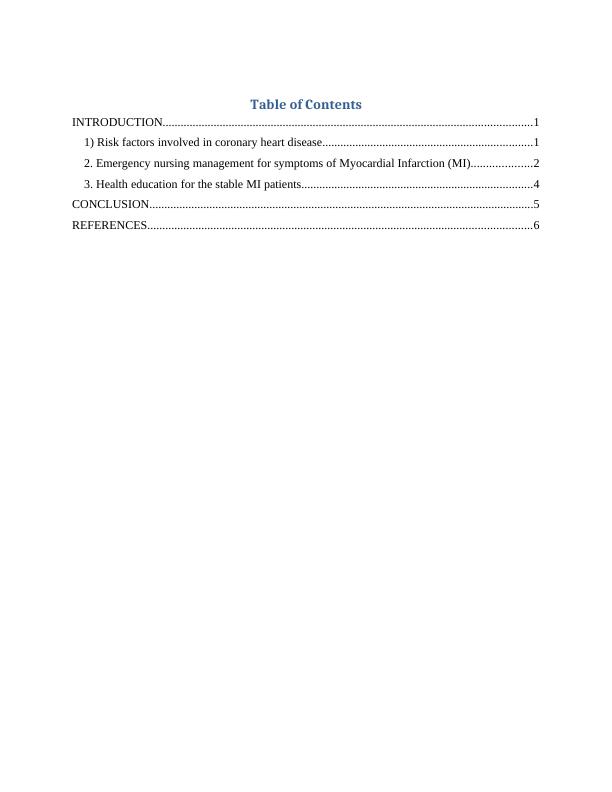Coronary Heart Disease Risk Factors PDF
Added on 2020-12-09
8 Pages2418 Words148 Views
Nursing

Table of ContentsINTRODUCTION...........................................................................................................................11) Risk factors involved in coronary heart disease......................................................................12. Emergency nursing management for symptoms of Myocardial Infarction (MI)....................23. Health education for the stable MI patients.............................................................................4CONCLUSION................................................................................................................................5REFERENCES................................................................................................................................6

INTRODUCTIONIn today’s time the main issue for death in people is coronary heart disease. The health careservices provided needs to be given at right time. This is because there are several risk associatedwith health care services which can result in critical consequences. Moreover, there are manyother things related to heart disease as well (Piepoli & et.al., 2016). It varies from person toperson. Besides this, it may be either traditional or non traditional factors. This essay willdescribe about risk factors that are associated with coronary heart disease. It will also explainnursing emergency management that is taken in patient with symptoms of myocardial infarction.In last section it will discussed about heath education given to MI client that is stable fordischarge. 1) Risk factors involved in coronary heart disease A coronary heart disease is most common heart disease in which arteries muscle becomenarrow and there is difficulty in supplying of blood. The muscle becomes hard or narrow due tobuilding up of cholesterol inside walls (Risk factors of coronary heart disease. 2016). It is verynecessary to identify those factors so that prevention methods can be taken. It will help inminimising risk and providing effective treatment to person. There are several signs andsymptoms of coronary heart disease. Besides this, there are different risk factors as well. Theyare divided into two categories that are traditional and non traditional risk factors. Traditionalrisk factor rises gradually as a person is not having any control on them. They are high bloodcholesterol, hypertension, diabetes, menopause, etc. High blood cholesterol is one of major riskfactor in which a person cholesterol level is high. Hypertension is also known as stroke.Usually, hypertension occurs without any symptom. This can result in long term affect on bloodvessels leading to heart attack. Diabetes is a mellitus chronic illness that is related tocardiovascular risk factor. A high increase blood sugar level may lead to heart attack. It isobserved that people having diabetes 2- 4 higher than normal are likely to suffer from stroke. Inmenopause a woman’s oestrogen level is highest during her childbearing years and declinesduring menopause. If menopause is caused by surgery to remove the uterus and ovaries, the riskrises sharply. In Obesity people who are overweight or fat are more prone to heart diseasedespite of having no symptoms (Coster, Watkins & Norman, 2018). This is because excess bodyweight puts pressure on strain in heart, raise blood pressure and lowers HDL. So, these all arerisk factors of heart disease. When a person is not engaged in any physical activity it leads to1

End of preview
Want to access all the pages? Upload your documents or become a member.
Related Documents
Case Study on Cardiovascularlg...
|10
|2204
|31
Role of a Nurse in Chronic Illness Managementlg...
|15
|4513
|74
ACUTE CORONARY SYNDROMElg...
|12
|3546
|1
Congestive Heart Failure | Solvedlg...
|10
|2744
|22
Holistic Care of Acute Myocardial Infarction Patientlg...
|12
|3084
|44
Coronary Heart Disease: Causes, Symptoms, Risk Factors, and Prevention Strategieslg...
|24
|1880
|212
